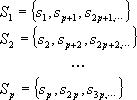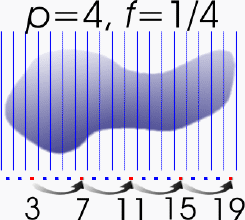One of the most important concepts in stereology is sampling. Sampling theory is a well-researched field of statistics and its use in stereology is a fundamental building block of methods such as the Optical Fractionator and the Cavalieri estimator.
Systematic Random Sampling
Systematic Random Sampling, commonly abbreviated as SRS, is the primary method used in stereological procedures. Systematic Random Sampling is known by several names. These include Systematic Uniform Random Sampling, or SURS (used in some stereology literature) and Systematic Sampling (as it is known in the field of Statistics). It is important to recognize that these terms all refer to the exact same concept.
SRS is straightforward to implement and has been shown to be an excellent method that reduces the variance when compared to Random Sampling (also known as Simple Random Sampling in the field of Statistics). In SRS, the researcher selects a fraction f. The fraction is selected as 1 over a whole number f=1/p. The symbol p is used because it stands for periodicity. The sets in this case are as follow:

Figure 1. Systematic Uniform Random Sampling sets.
This method is unbiased as long as the set is chosen in a random manner. To include randomness in the selection, a random number from 1 to p is chosen as the starting point.

Figure 2 shows a diagram of an organ that was sectioned using a uniform distance between sections. In this example, the periodicity was chosen as 4. This makes the fraction 1/4. A random starting number from 1 to 4 was chosen and the number selected was 3. The SRS set of sections were thus 3, 7, 11, 15, and 19. These 5 sections of the object represent a fraction of 1/4 of the original object. If the random number had been 4, then sections 4, 8, 12, and 16 would have been chosen. Although there are only 4 sections in the set when 4 is chosen as the starting section and 5 sections in the set when 1, 2, or 3 is chosen, all 4 possible sets of sections have the same fraction of 1/4.
____________________________________________________________________

Sponsored by MBF Bioscience
developers of Stereo Investigator, the world’s most cited stereology system